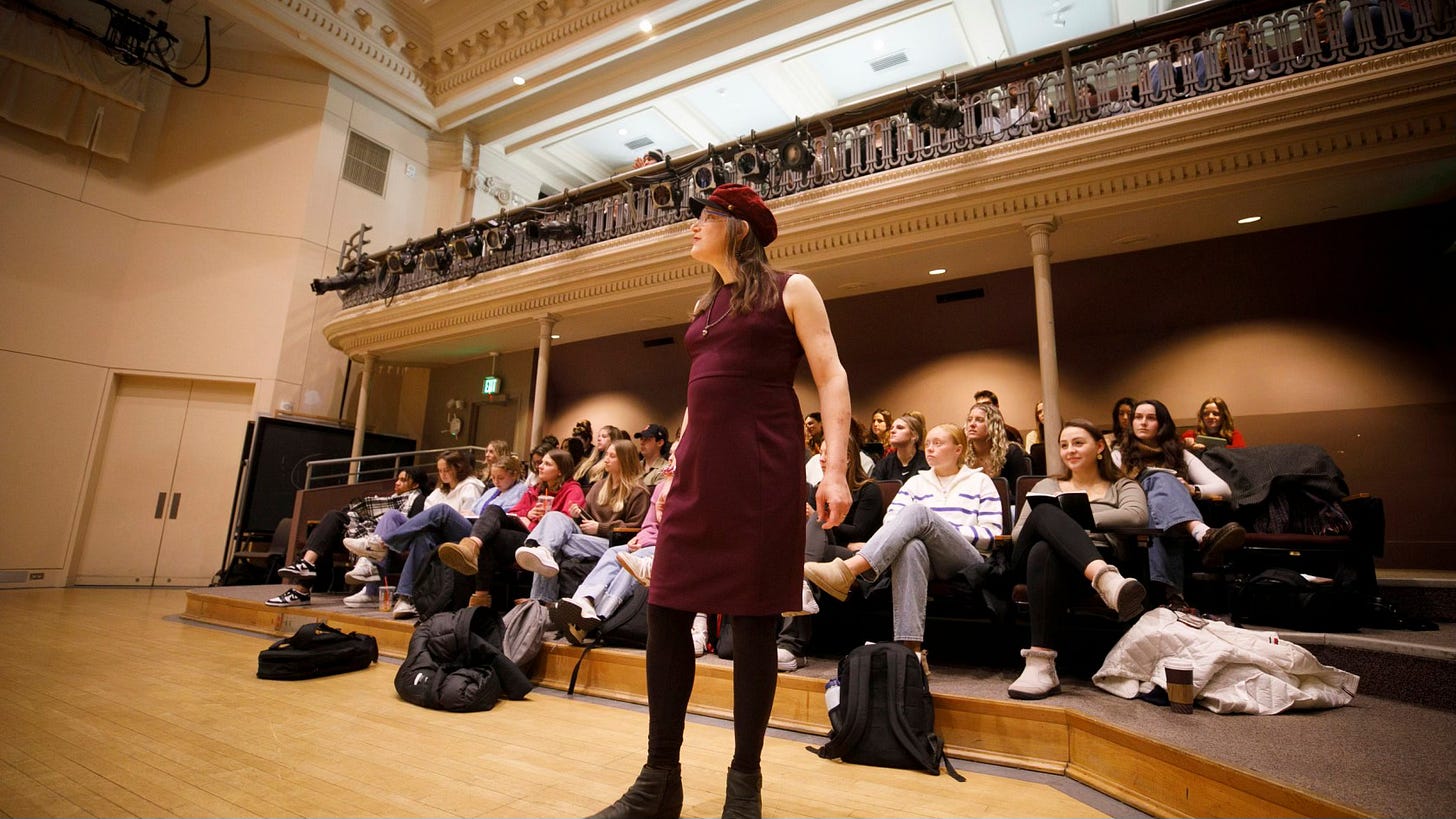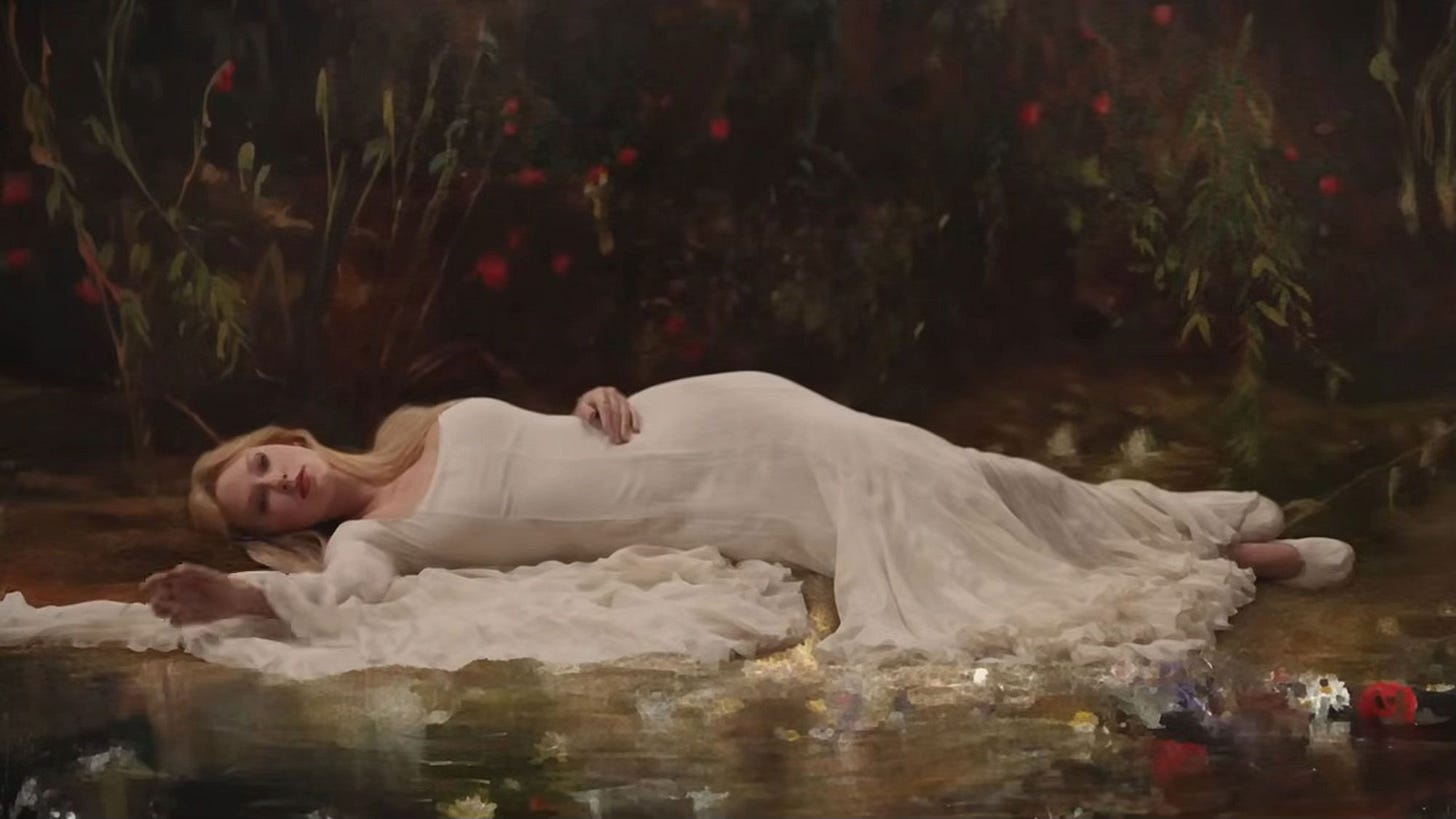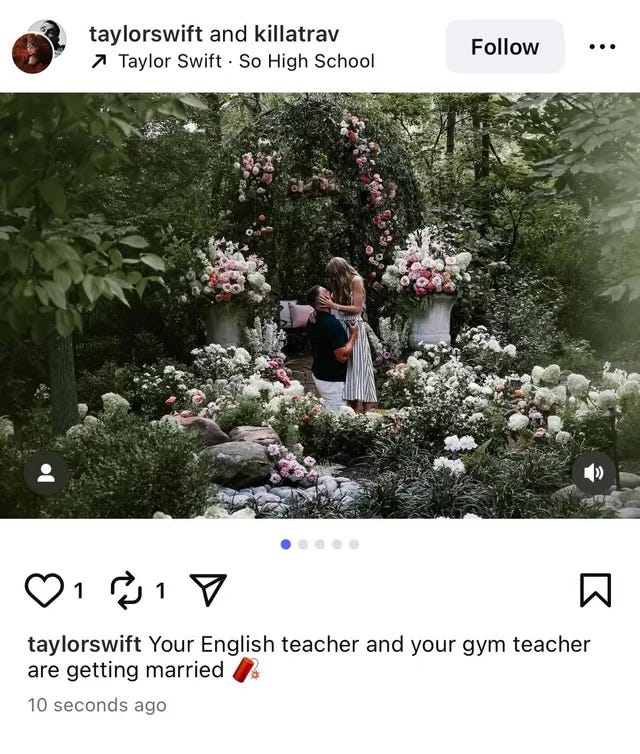The kids don’t read poetry, but they do listen to music. Poetry is stuffy, academic, old-fashioned; music is fun, democratic, infectiously modern. Poetry makes you want to yawn; music makes you want to get up and dance. In 2016, Bob Dylan was awarded the Nobel Prize in Literature. When I was at Cornell, a class in the English department was offered on Beyoncé. At Harvard, English professor Stephanie Burt drew outsized media attention when she started a course on Taylor Swift, putting Swift’s music in conversation with the literary works of John Keats and James Merrill, William Wordsworth and Willa Cather. So we are a long ways off from the era in which Virginia Woolf made a foray into the “Battle of the Brows,” picking apart highbrow and lowbrow and middlebrow, distinguishing brow from brow. All the brows have melded into a single unibrow; everything in our culture is now fair game for in-depth analysis, academic monographs, serious study.
In the case of Taylor Swift, Swift herself seems to encourage and reward this study. Her songs reference Shakespeare and the Lake Poets. She presents herself first and foremost as a songwriter; she knows that storytelling is the spine of her art. Announcing her engagement to football player Travis Kelce, she wrote, “Your English teacher and your gym teacher are getting married”—English teacher, not music teacher. Kelce, in fact, serves as the perfect lowbrow foil for her highbrow literary pretensions, he filling stadiums on account of his brawn, she her brains, she using the word “esoteric” to describe an album, he teasing, “She’s so hot when she says big words.” It is no wonder, then, especially after the explosive success and cultural omnipresence Swift has enjoyed over the past few years, that a book like Taylor’s Version: The Poetic and Musical Genius of Taylor Swift would come out. In it, Stephanie Burt collects the fruits of her Harvard course and traces the progression of Swift’s artistry from album to album.
Taylor Swift began as, if not a prodigy of country music, at least a precocious producer of it, writing the songs that would first propel her to fame in her early to mid-teens. The ambition to find a place in the world of country music came to her early, from inspirations like Faith Hill and LeAnn Rimes (Rimes, rising to prominence at age 13, must have been especially aspirational). Luckily for Swift, her parents were not only uncommonly wealthy but also uncommonly supportive. They sent her to Britney Spears Camp in Cape Cod, where Spears herself was present; they encouraged her when she modeled for Abercrombie & Fitch; they cheered her on when she performed in musical theater; they drove her to sporting events, where she could expose herself to large audiences by singing the national anthem, and down to Nashville, so she could give her karaoke demos to record company executives. Rejected by those executives, she realized that she had to do something to stand out, and that that something would be writing her own songs. Swift’s parents uprooted the family to Nashville; a “computer repairman” taught Swift some chords on the guitar; Swift practiced four hours a day until her fingers bled and took songwriting lessons from local talents; at a showcase at the Bluebird Cafe, she performed in front of Scott Borchetta, who had started his own label, Big Machine Records; he signed her, and the rest is history.
Even in this early account we can see the three seeds, the three theses Stephanie Burt puts forth in Taylor’s Version to explain Swift’s success and defend claims of her genius. First, Swift herself writes the songs that she sings. Second, Swift is a hard worker and a people-pleaser. Third, and most importantly for Burt, Swift is both relatable and aspirational. The relatability is easy to spot in her first few albums: she sings of teen crushes and heartbreak, of bullies and feeling excluded at school. What was aspirational about her was her ability to take this common stuff of life and distill it into art, to take her own particular experience and render it universal. Then, as her fame and wealth and success grew, it was easy to see why she’d be aspirational. She kept the relatability through her emotional vulnerability, excavating her anxieties (Midnights) or tuning in to the introspective, contemplative quiet of pandemic isolation (folklore and evermore).
Burt is a steady, clear-eyed guide through Swift’s first 11 albums and the Eras Tour. She weaves in biography deftly, using it to illuminate certain aspects of Swift’s music and deepen our understanding of Swift’s choices, to explain a lyric or a change in musical direction or the love story propelling a song’s narrative. Though each of the book’s chapters treat a single album, they don’t prevent Burt from making connections across albums or, sometimes, to the work of other artists. And her self-identification as a devoted Swiftie does not prevent her from acknowledging valid criticisms of Swift or even criticizing Swift herself when she needs to. For example, she refers to the Anglophilia of “London Boy,” where Swift conjures up “high tea, stories from uni, and the West End” as “skin-deep” and “frankly ridiculous.”
For every album, Burt not only bolsters her threefold thesis but also unravels the album’s particular sonic, symbolic, thematic skein. Fearless is where we get a discussion of “hermeneutic friendship,” the kind of friendship a work of art gives you when it takes you by the hand, the Virgil to your Dante, and guides you with its advice and understanding. Speak Now is a Bildungsroman or Künstlerroman that both looks back to past memories and forward to future possibilities. In the Red chapter, Burt allows herself the space for a lyrical meditation on love and especially “red love,” Swift’s red scarf and autumn leaves potent symbols of this love, along with the album’s interest in cars and driving. Reputation gives Burt a chance to talk about Swift and race, the ways that Swift’s use of R&B, hip-hop, and rap allowed her to move beyond the innocence American culture associates with whiteness, and whether this use of Black culture is respectful incorporation or disrespectful appropriation.
There are moments when Burt hammers a little too hard on the relatable-aspirational dyad, becoming redundant. One also starts to wonder whether these three pillars—that Swift is ambitious and works hard, that she writes her own songs, that she is relatable and aspirational—are enough to support the load of the “poetic and musical genius” claim. What is it, exactly, about Swift’s hard work and ambition—and her self-presentation as a hard worker having to prove herself to her fans, her critics, her detractors, over and over again—what is it about her songcraft, what is it about her relatable, aspirational nature that sets her apart from her peers, explains her stratospheric commercial success, and makes her not just talented but worthy of the “genius” label?

Swift is not the best belter, and the structures of her songs are relatively simple. Yet, in her versatility and reinvention, she borrows and combines distinguishing elements of disparate genres. Even after leaving the country music scene, she has kept country music’s flair for storytelling; I like how her songs often give you a twist in the last chorus, changing perspectives or lines in order to add a new meaning to old words, deepening the narrative. In her first album, the second line of “He’s the reason for the teardrops on my guitar / The only thing that keeps me wishing on a wishing star” changes to “The only one who’s got enough of me to break my heart,” a devastatingly simple summation of the consequences of investing one’s emotional resources into an unrequited love. From pop, even when she’s not working in that genre, her songs have an undeniable catchiness, an ability to burrow in through the ear and snake around the brain. With her confessional lyrics, passionate intensity, and frequent portrayal of herself as the wronged underdog, she channels a kind of rock star self-mythologizing, even if she rejects—as Burt elucidates in her discussion of The Tortured Poets Department—messiness and lawlessness for craft and control, precision and intention. Her pandemic albums show her at home in folk music’s gentle introspection. She has a rapper’s ear for end rhymes and vowel rhymes, internal rhymes and half-rhymes.
It is these qualities—aliveness to language, attention to narrative, the construction of a parallel world of memory and imagination that takes you deeper once you step into it, the fact that her work “not only solicits attention but rewards it”—that make Swift plausible as a worthy subject not just of musical or business study but of literary study. Burt is best when marshaling her considerable resources as a poetry critic not towards making rather superficial connections with John Keats or Alexander Pope but in undertaking close readings of songs, in illuminating Swift’s frequent use of the “trucker gearshift” or what she does with the fraught fifth track on each album, in helping us see her imagery or rhetorical devices. She points out mondegreen (how Swift’s accents on “long list of ex-lovers” made fans hear it as “all the lonely Starbucks lovers”), syllepsis (“I feel so high school every time I look at you / But look at you!”), zeugma (“You crashed my party and your rental car”). One could add more obvious ones like alliteration (“Blew through the money on the boys and ballet”), consonance (“redneck heartbreak”), metaphor (“Now I’m begging for footnotes in the story of your life”), tautology (“Life is a song, it ends when it ends”). Simile is combined with vivid imagery (“The moon like a spotlight on the lake”; “Autumn leaves falling down like pieces into place”), with metaphor (“Darling, I’m a nightmare dressed like a daydream”), with antithesis (“You kept me like a secret, but I kept you like an oath”).
A large swath of contemporary poetry has largely jettisoned rhyme and rhetoric, rich storytelling, traditional form, humor, satire, relatability, memorable phrase-making, or even imagination. Really and truly harnessing these, poets probably still won’t draw the kinds of crowds Swift does—after all, poetry is poetry and pop music is pop music. But people do hanker after a good story told well, heroes they can relate to and root for, villains they can hate, wisdoms condensed into single lines, images that populate the inner landscape. Language—in all its slippery trickery—is largely underutilized and underrated, I think, today, especially by those you’d largely expect to revel in it. But rhymes chime, similes signify. People are longing to be haunted and enchanted, and it’s Swift who speaks to them, maybe not forever and always, but at least for now.
Dear Readers, you are probably sick and tired and saturated with Swift, but for more Taylor Swift reading, I loved
’s review of The Life of Showgirl and ’s discussion of Swift’s posturing as an “English teacher.”If you enjoyed reading this review, please share with a friend, a Swiftie, a Swift-hater, leave a like, and let me know your thoughts in the comments, as I always enjoy hearing from you!






I demand a course on Hyun Woo Kim at either Harvard or Cornell.